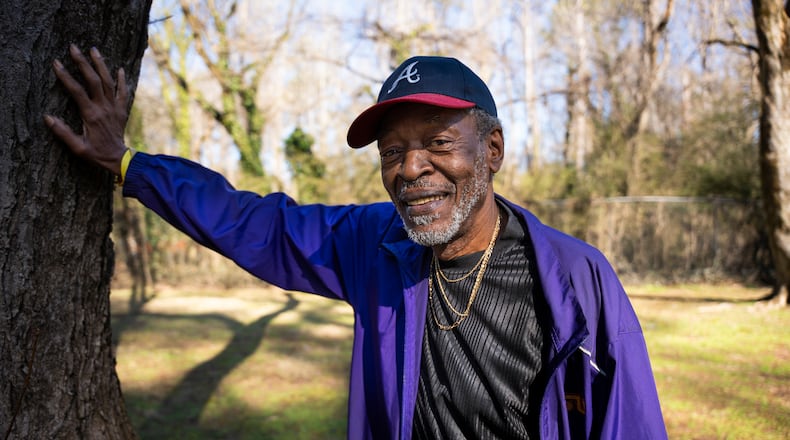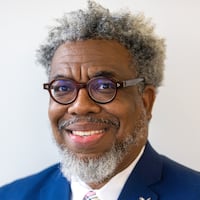Fernando Jones couldn’t find the tree.
Earlier this week, for the first time in years, Jones visited the site of the old Carrie Steele-Pitts Home on Fairburn Road, the orphanage where he grew up.
When he was 5 years old, he and his baby sister, Eugenia, were placed there after his mother, who had several run-ins with the law, “put us in there because she kept getting into trouble.”
Looking out over the 26-acre campus Jones searched for a tree that he fell out of once.
Credit: Olivia Bowdoin
Credit: Olivia Bowdoin
“I saw someone else climb the tree so I tried it,” he said. “A branch broke and I came down. I don’t know how long I was down there.”
From the time of his arrival, until he graduated from college, Jones would call that orphanage, founded by a former slave, his home.
“The home was our life,” said Jones, now 70.
For 137 years, the home has been life to more than 25,000 boys and girls who were orphaned or part of the state-run foster system.
The story that Jones tells of being dropped off is not unheard of.
The orphanage was founded in 1888 by Carrie Steele, a former maid.
Credit: Internet Archive American Librar
Credit: Internet Archive American Librar
Born into slavery in 1829, Steele was orphaned as a small child.
Some time after 1865, when the 13th Amendment abolished slavery in the United States, Steele and her 17-year-old son, Robert, moved from Macon to Atlanta, where she secured a job as a maid at the Central of Georgia Railway passenger depot downtown.
By 1881, she was able to save enough money to buy a modest $1,600 house on Wheat Street (now Auburn Avenue), making her one of Atlanta’s first Black landowners.
Credit: Courtesy Atlanta History Center
Credit: Courtesy Atlanta History Center
In the late 1800s, with the advent of the railroad system, it became a disturbing practice for some poor or distressed parents to abandon their children at train depots, because they knew they would be found. On several occasions, Steele, while working at the station, found Black babies who had been abandoned in restrooms and waiting rooms.
Steele took them home, where she fed and cared for them.
Credit: Olivia Bowdoin
Credit: Olivia Bowdoin
In 1888, struck by the number of orphans she was continuing to find around Atlanta, she founded the Carrie Steele Orphan Home.
By 1892, having outgrown her home, Steele constructed a three-story brick structure on Roy Street for $5,000 to provide a home for 50 Black children.
“We were the first established orphanage for children of color, but we accepted anyone, regardless of race,” said Eloise Mitchell, the interim director of what is now the Carrie Steele-Pitts Home. “But we were the ones who took the children of color when other orphanages did not.”
Credit: Internet Archive American Librar
Credit: Internet Archive American Librar
Steele funded the orphanage through state and local grants, donations, touring the country as a speaker and from sales of her autobiography.
She and her staff trained the children in basic education, as well as morality, domestic training, sewing, house cleaning and gardening.
“It is appointed to me in my old age to accomplish what I believe to be a great and glorious work and one that shall live long after my poor frail body has dropped into the dust whence it came,” Steele wrote. “(The orphanage) is meant to care for and train to honest labor the hundreds of colored orphans who are growing up as material for the chain gang.”
The orphanage changed its name in 1950 to the Carrie Steele-Pitts Home in honor of Steele’s longtime successor, Clara Maxwell Pitts.
Credit: Olivia Bowdoin
Credit: Olivia Bowdoin
Steele’s contributions have been noted through the years.
In 2023, the group behind Atlanta’s $5 billion Gulch redevelopment renamed the downtown Nelson Street Bridge after Steele. Jones attended the naming ceremony and was struck by how little information was available about Steele.
Jones, who was among the children who moved from the Roy Street home to a new facility on Fairburn Road in the mid-1960s, has found a rare copy of Steele’s autobiography and is now writing his own book about her.
“I want to bring her back to life and let people know about her,” Jones said.
The Carrie Steele-Pitts Home still exists, but its mission has changed to focus on foster children rather than orphans.
In 2023, the organization sold the Fairburn Road property, hidden in a Northwest Atlanta neighborhood buttressing I-285, because they were getting so few children that they could not sustain themselves. Through an independent living program, they have apartment space in Southwest Atlanta to house about five young people who have aged out of the foster care system, but no one is currently enrolled in the program.
Credit: Olivia Bowdoin
Credit: Olivia Bowdoin
Still, Mitchell said they annually reach and serve about 600 children between the ages of 13 and 21 through other services.
Visiting the campus last week and looking for his tree, tears occasionally filled Jones’ eyes. He points to where the fishing creek was and where he and the other kids played basketball. He used to swing a baseball bat left-handed and smiled remembering his best swing that broke a window.
He stops by an old stone placard affixed to one of the old cottages.
The sign is supposed to read CARRIE STEELE ORPHAN HOME, but at some point — Jones doesn’t know when — the kids crudely scratched out the word “orphan.”
Credit: Olivia Bowdoin
Credit: Olivia Bowdoin
“I don’t like the word orphan,” Jones said. “Everything didn’t go the way I wanted it to, but I wish the home was still here. I had a better chance here than I ever would have had at home with my mama.”
Jones was a resident of the home until he graduated from Tennessee State University. His sister, Eugenia, graduated from what was then Bethune-Cookman College.
A third sister, Dorothy, was born later and continued to live with his mother. She was murdered in 1977 at the age of 18.
“She didn’t get to live here,” Jones said, tapping the stone sign. “Had she been here, she might have had a better chance in life.”
Credit: Olivia Bowdoin
Credit: Olivia Bowdoin
When Steele died in 1900, more than 3,000 people were said to have attended her funeral. She was buried in Oakland Cemetery.
Her gravestone reads: “The mother of orphans. She hath done what she could.”
ABOUT THIS SERIES
This year’s AJC Black History Month series, marking its 10th year, focuses on the role African Americans played in building Atlanta and the overwhelming influence that has had on American culture. These daily offerings appear throughout February in the paper and on AJC.com and AJC.com/news/atlanta-black-history.
Become a member of UATL for more stories like this in our free newsletter and other membership benefits.
Follow UATL on Facebook, on X, TikTok and Instagram.
About the Author
Keep Reading
The Latest
Featured














